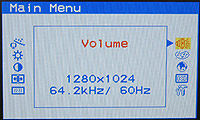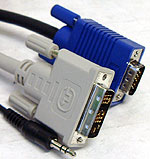|

|
The 3" thick display panel takes up only a fraction of the desk space of an equivalent 50LB monster 19" CRT monitor.
82% Rating: 
|
|
|
|
Home >
Reviews >
Monitors >
Cornea CT1904 |
|
|
The OSD and Display Evaluation Notes
Cornea
have a clean layout for their OSD that makes adjusting aspects pretty straight
forward. When the monitor is connected via the Digital DVI cable many of the screen adjustments are blocked out
because they are not required for that type of signal. The main
sections include; auto-adjust, brightness, contrast, position, image, volume, colour, language, OSD adjust, and
miscellaneous.

As with all LCD capable of analog-input,
the best way to configure that method of connection to the computer is to toggle
the Auto adjust key and just sit back.
| PCstats TFT Display Evaluation
Criteria: |
|
We evaluate the quality of TFT displays with
the help of a program called Nokia Monitor Test. The software application
displays a range of colours and test patterns that can help diagnose just
about any visual problems or defects a TFT display may contain.
It can also be a very useful tool for
properly adjusting a display to the optimal settings. The software
consists of eleven tests which can be run in steps as adjustments are made
to the OSD. As the tests are run we look for the following problems, only
one of which should be inoperable (broken pixel).
Broken Pixels: What we class as a 'broken pixel' can
fall under any one of the following circumstances: Pixel always on (any
colour), pixel always off, pixel unable to display a shade (red, green,
blue, black, white), pixel shown colour gradient.
Pixel Clock: If the number of dot clocks within one
horizontal synch are not properly configured the screen will appear to
drift or vertical stripes may be generated. This should be correctable by
the on screen menu.
Phase: If the phase of the display data and dot clock
are not correctly tuned the screen can flicker, or text be displayed
blurry. For example text may appear dithered, or when looking at a test
pattern of a one-pixel black, one-pixel white checkerboard pattern the
pattern may be distorted. This should be correctable by the on screen
menu.
Response Time: We look for any streaking associated
with moving a full page of text up or down quickly. Displays with slower
refresh rates tend to show some degree of image streaking or text
discoloration which can be distracting.
Stand Stability: TFT displays are fragile components and the
stand should offer adequately stable support as well as be easily
adjustable.
We deduct marks for quality control if there are any predominant
broken pixels in a display. While many manufacturers may consider a
few broken pixels acceptable, we believe the high cost of TFT displays
should translate into a clear and unblemished image. |
|
| Display Test System
Configuration: |
|---|
 |
Video Card: |
ATI Radeon 8500 |
| Operating System: |
MS Windows 2000 |
| Display Settings: |
Color Temp: 6500K
Resolution: 1280x1024
pixels
Frequency: 60Hz, digital DVI connection
Colour: 32
Bit |
|
|
| LCD Display Test |
Test Notes and Observations |
|
| Geometry: |
There typically isn't much to say
about the geometry of a screen when we are dealing with LCD's. The technologies
inherent design means that test grids are displayed very true, and very
sharp at their native resolutions, especially when using DVI signals. The Cornea
CT1904 does well under native resolutions like 1280x1024 as we would have expected.
|
| Brightness and Contrast: |
There is very
subtle shading differences between 1% and 9% white on the contrast test
screen. The 205 through 100% also shows an even transition,
but the 100% test square seems to remain a little gray.
There is no perceptible bleed on the small white box test
page, and the uniformity of the black is nice. The LCD glass
doesn't have the greenish
appearance that the previous Cornea LCD had, though there was at least one/half of
a broken pixel visible. |
| Colour: |
White uniformity is quite good, as are red, green and blue test screens.
There were no visible dull areas around the outside edges of the screen,
and only that one-half or maybe even 1/3 of a broken pixel visible
to are critical eyes.
|
| Convergence: |
The grid test patterns in RGB illustrate the worst
case situations when different coloured pixels must work closely together. Since
the pixels on the CT1904 are 0.294mm in size, the different parts of the pixel (RGB) they
do not line up exactly on LCD screens where there is less
blending between adjacent cells. Overall, the convergence of this display was excellent.
|
| Focus: |
This test has a
few patterns of alternating
black and white boxes with text in them. In the center of the
page are two boxes with 1 pixel vertical stripes. All test patterns showed up
perfectly - if you try this test on your monitor pay close
attention to the center two gray boxes, where interference can sometimes
be visible. |
| Resolution: |
Resolution was
excellent at the native 1280x1024 setting under both analog and digital
signals. We then reset the image size to 1024x768 and loaded up the
resolution test pattern once again. Under those conditions the image dithering of closely spaced lines was less
clear, though text was easily readable. |
| Moire: |
Since we tested
with the digital signal there were no
problems at all with any of the Moire test patterns.
Under an analog signal we did see some background waviness crop up
on a couple of the 1pixel vertical, and cubed, test
patterns. |
|
Other Evaluation Notes: |
The LCD display
on the Cornea CT104 is quite good under a digital signal, but
not as much so under
the standard analog connection. On most of the LCD's
we have tested it has always been rather difficult to make the distinction between
a digital or analog signal, but in this case it is visible. Ghosting
doesn't seem to a be a problem with this display, and in testing with
a full page of text there was no streaking either. |
|
|
|
|
|
|
|
